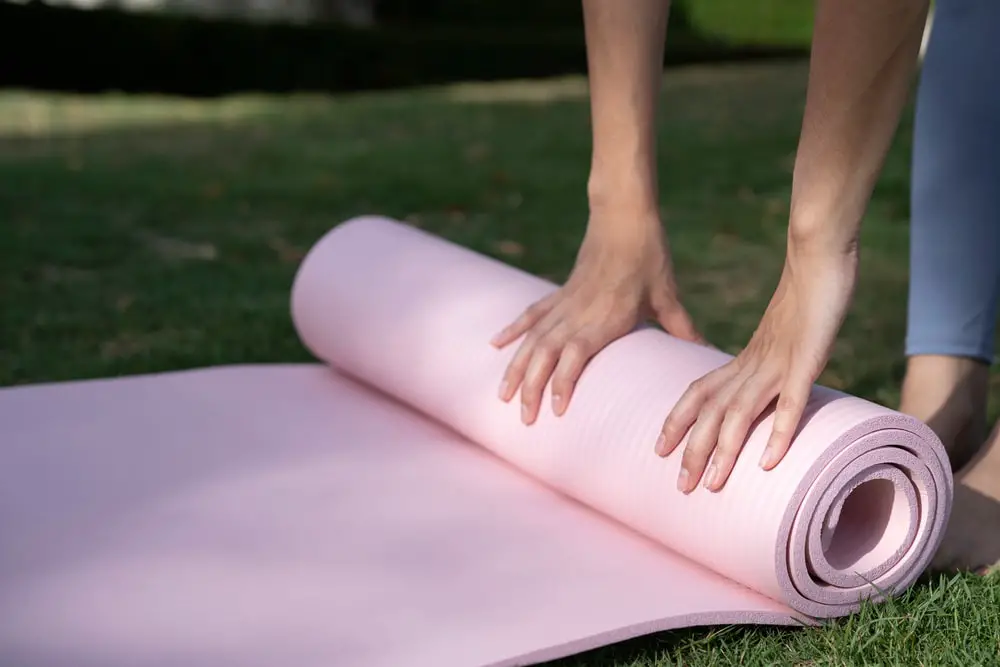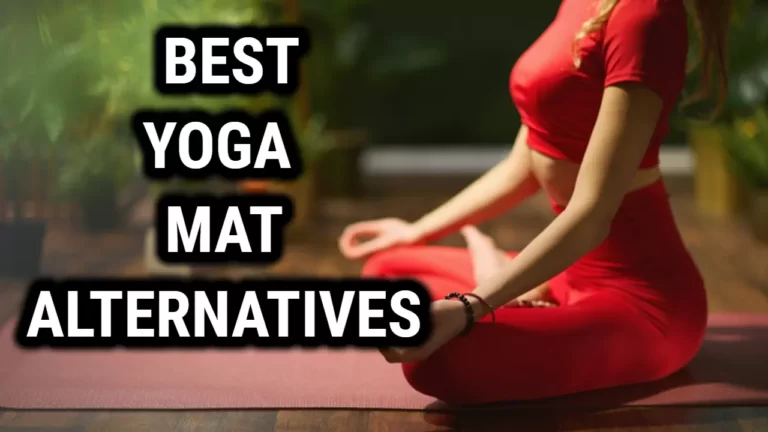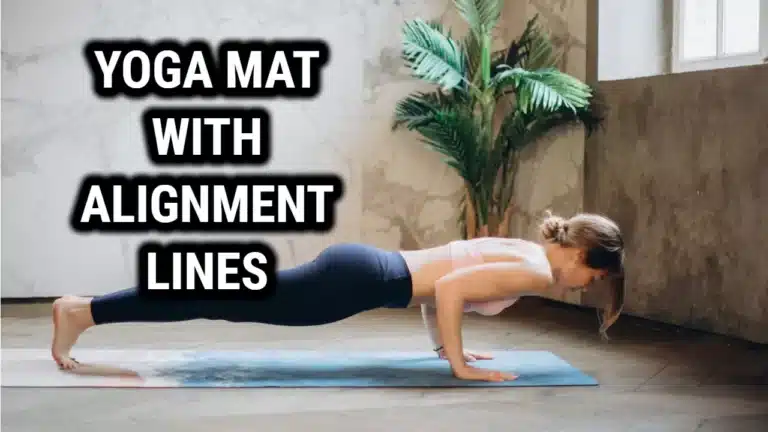What Is The Best Thickness For Yoga Mats

Are you a yoga enthusiast looking for the perfect yoga mat? Well, look no further because this article will guide you on finding the best thickness for your yoga mats. Understanding the importance of yoga mat thickness is crucial in maximizing your practice. Whether you prefer a more challenging workout or seek extra cushioning and support, the thickness of your mat plays a significant role.
Consider your specific yoga practice and its intensity level when deciding on the ideal thickness. Thin mats offer better stability and balance during strength-focused exercises, while thick mats provide added comfort during longer sessions or gentle practices. Both options have their pros and cons.
To make an informed decision, it is essential to consider various factors such as durability, portability, and personal preference. Testing and trying out different thicknesses can also help determine what works best for you.
So get ready to enhance your yoga experience by finding the perfect thickness for your mat!
Key Takeaways
- The best thickness for a yoga mat depends on factors such as durability, portability, personal preference, yoga style, intensity level, body type, and physical conditions.
- Thicker mats provide comfort, support, and cushioning for sensitive joints, making them suitable for kneeling or lying down poses.
- Thin mats offer stability, balance, and increased muscle engagement, making them ideal for standing postures.
- Testing different thicknesses can help enhance comfort during yoga practice, and assessing portability is important when trying out different thickness options.
Understanding the Importance of Yoga Mat Thickness
If you’re serious about your yoga practice, you’ll quickly realize the importance of finding the perfect thickness for your mat. The thickness of a yoga mat plays a crucial role in providing comfort and support during your practice.
A thicker mat can offer more cushioning, which is especially beneficial if you have sensitive joints or prefer a gentler practice. On the other hand, a thinner mat allows for better stability and balance, making it ideal for those who enjoy challenging poses or prefer to feel connected to the ground.
It’s essential to choose a thickness that suits your personal needs and preferences. Experimenting with different thicknesses will help you find the one that feels just right for your body and enhances your overall yoga experience.
Consider Your Yoga Practice
When choosing a mat, think about your yoga routine and find the perfect thickness that supports your practice. Consider the type of yoga you usually engage in and how much cushioning you need. For gentle or restorative practices like Yin or Hatha yoga, a thicker mat with more padding can provide extra comfort during longer holds.
On the other hand, for dynamic and intense styles like Ashtanga or Vinyasa flow, a thinner mat offers better stability and support for balancing poses and transitions. Take into account your body’s needs as well; if you have sensitive joints or injuries, opting for a thicker mat can help cushion impact and reduce discomfort. Remember to also consider portability and storage when selecting your ideal thickness.
| Yoga Style | Ideal Thickness | Benefits |
|---|---|---|
| Restorative | 6mm | Extra comfort during long holds |
| Hatha | 6mm | Cushioning for gentle movements |
| Ashtanga | 4-5mm | Stability for dynamic poses |
| Vinyasa | 4-5mm | Support during transitions |
| Bikram | 3-4mm | Heat resistance |
This table can serve as a helpful guide in determining the best thickness for your specific yoga practice. Keep in mind that personal preference also plays a role, so it’s worth trying out different thicknesses to find what feels most comfortable and supportive to you.
Pros and Cons of Thin Yoga Mats
Although thin yoga mats offer better stability and support for dynamic poses, they may lack the extra cushioning needed for longer holds or gentle movements.
With a thin mat, you can feel connected to the ground, which enhances your balance and helps you maintain proper alignment during challenging postures. The firmness of a thin mat also allows you to engage your muscles more effectively, providing a solid foundation for strength-building exercises.
However, when it comes to restorative or gentle practices that require prolonged periods of relaxation, a thin mat might not provide enough padding to keep you comfortable. Additionally, if you have sensitive joints or injuries, the lack of thickness could exacerbate any discomfort you may be experiencing.
Ultimately, choosing a thick or thin yoga mat depends on your personal preferences and the type of practice you engage in.
Pros and Cons of Thick Yoga Mats
For a plush and cushioned experience during your practice, imagine sinking into a cloud as you step onto a thick yoga mat. Thick yoga mats provide extra padding and support for your joints, making them especially beneficial for people with sensitive knees or those who prefer more cushioning. However, there are also some drawbacks to consider.
Thick mats can be heavier and bulkier, making them less portable and harder to carry around. Additionally, they may affect your balance and stability during certain poses due to their softness. To help you understand the pros and cons of thick yoga mats better, here is a table that compares their advantages and disadvantages:
| Pros | Cons |
|---|---|
| Extra cushioning for joints | Heavier and less portable |
| Suitable for people with sensitive knees | May affect balance in some poses |
| Provides more comfort during the practice |
Ultimately, the choice between thin and thick yoga mats depends on personal preferences and individual needs.
Factors to Consider When Choosing Thickness
Choosing the right thickness can greatly impact your comfort and performance during your yoga practice, allowing you to fully immerse yourself in the experience. When considering the thickness of a yoga mat, there are several factors to keep in mind.
Think about the type of yoga you primarily engage in. If you prefer more gentle styles like Hatha or Restorative, a thicker mat around 6mm may provide extra cushioning for your joints and added support during poses. On the other hand, if you practice more intense forms such as Vinyasa or Power Yoga, a thinner mat around 3-4mm might be preferable as it allows for better stability and balance.
Consider your body type and any specific physical conditions you may have. Thicker mats can help alleviate pressure on sensitive areas like knees and wrists while thinner mats offer a firmer surface for those seeking greater proprioception.
Testing and Trying Different Thicknesses
Experimenting with various thicknesses will allow you to find the perfect fit for your practice and take your yoga experience to new levels. Here are three sub-lists to help you enjoy what’s written:
- Different poses: Trying different mat thicknesses can enhance your comfort level during various yoga poses. For example, a thicker mat may provide more cushioning during kneeling or lying down poses, while a thinner mat might offer better stability for standing postures.
- Body support: Testing out different thicknesses can help you determine which one provides the best support for your body. Thicker mats may be beneficial if you have joint issues or prefer extra padding, while thinner mats could be suitable if you value a closer connection to the ground.
- Portability: By trying out mats of different thicknesses, you can assess their portability factor. Thinner mats tend to be lighter and easier to carry around, making them ideal for travel or outdoor practices. On the other hand, thicker mats might be more suitable if you prioritize cushioning and don’t mind the additional weight when transporting them.
Enjoy exploring various thickness options and discover what works best for your unique yoga practice!
Frequently Asked Questions
Can I use a thick yoga mat for intensive yoga practices?
Yes, you can use a thick yoga mat for intensive yoga practices. The extra cushioning provides more support and comfort for your joints during challenging poses, making it ideal for rigorous workouts.
Are thin yoga mats suitable for beginners?
Thin yoga mats can be suitable for beginners as they offer better stability and balance. However, some beginners may prefer a slightly thicker mat for added comfort and cushioning during their practice.
What are the potential drawbacks of using a thin yoga mat?
Using a thin yoga mat may have potential drawbacks. It might not provide enough cushioning, making certain poses uncomfortable or putting strain on your joints. Consider a thicker mat for better support and protection.
Can the thickness of a yoga mat affect my balance and stability during yoga poses?
Yes, the thickness of a yoga mat can indeed affect your balance and stability during yoga poses. A thicker mat provides more cushioning and support, helping you stay stable and balanced throughout your practice.
Are there any specific yoga styles that require a certain thickness of yoga mat?
Certain yoga styles, such as restorative or gentle yoga, benefit from thicker mats to provide extra cushioning and comfort. However, more dynamic styles like Ashtanga or Vinyasa may require a thinner mat for better stability and connection to the ground.
Conclusion
So there you have it! When it comes to choosing the best thickness for your yoga mat, it ultimately depends on your personal preferences and yoga practice. Thin mats offer better stability and connection to the ground, while thick mats provide more cushioning and support.
Consider factors such as comfort, balance, and portability when making your decision. Don’t be afraid to test out different thicknesses and find what works best for you.
Happy practicing!





